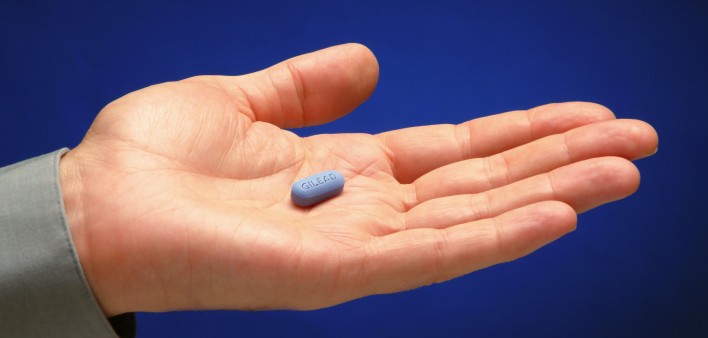A nondaily intercourse-based dosing protocol for Truvada (tenofovir disoproxil fumarate/emtricitabine) as pre-exposure prophylaxis (PrEP) appears highly effective at preventing HIV among men who have sex with men (MSM).
A new analysis of a placebo-based trial of the dosing protocol (also known as on-demand PrEP) helps address concerns about the protocol’s effectiveness among individuals who have sex relatively infrequently and therefore do not maintain at least a moderate level of Truvada in the bloodstream. Statistical analyses of Truvada have suggested that as few as four to six doses per week still confers maximum, or near-maximum, protection against the virus.
Guillemette Antoni, MD, PhD, of the Institut national de la santé et de la recherche médicale (Inserm) in Paris, presented this new analysis at the 9th International AIDS Society Conference on HIV Science in Paris (IAS 2017).
In 2012, the IPERGAY study began recruiting high-risk French and Canadian MSM and randomly assigned them to receive Truvada or a placebo. After the placebo phase ended, the men were invited to participate in a subsequent open-label phase, during which everyone knew they were receiving Truvada.
The new analysis concerned 361 participants in the placebo phase of the study.
From the start of the study, the men were instructed to take two doses between 24 and two hours before intercourse (or one pill, if the most recent dose was taken between one and six days before) and then, if intercourse occurred, to take one dose every 24 hours after that first dose, until they had taken two pills since the last time they had anal sex.
The men made study visits once monthly for the first two months of the study and then switched to every other moth. They returned their pill bottles at each visit so the investigators could count the number left over.
In 2015, researchers reported data on 414 members of the study. Two members of the Truvada arm contracted HIV during 219 cumulative years of follow-up, for an infection rate of 0.91 percent per year. Fourteen members of the placebo arm contracted the virus during 212 cumulative years of follow-up, for an infection rate of 6.6 percent per year. The researchers therefore found that the dosing protocol was associated with an impressive 86 percent reduction in HIV risk in the group that received Truvada. (By contrast, the placebo-controlled 2010 iPrEx trial saw only a 44 percent HIV risk reduction among the group that received Truvada compared with the group that received a placebo.)
The actual cause of this risk reduction remained unclear, on account of the fact that the IPERGAY participants took a relatively high number of pills per month—a median of 15 tablets, or about four per week. (They engaged in a median 10 sex acts monthly.) No one in any of the previous clinical trials of daily PrEP who was apparently taking four or more tablets per week contracted HIV. So in IPERGAY, were the particulars of the dosing schedule itself responsible for the considerable HIV risk reduction, or was it just the overall frequency of pill taking?
In order to answer this question, the investigators conducted a new analysis, looking at periods between two consecutive study visits when participants in the placebo phase of the study reported using 15 or fewer tablets of Truvada per month and also reported using intercourse-based PrEP “systematically or often” for acts of sexual intercourse, as opposed to “from time to time or never.” The investigators pooled together the participants’ follow-up time that hewed to this pattern of reported pill use.
Six participants who reported such pill-taking patterns contracted HIV during such periods. All six infections were in the placebo arm, which included 64.8 cumulative years of follow-up, amounting to an infection rate of 9.3 percent per year. The zero infections among those in the Truvada arm occurred during 68.9 cumulative years of follow-up. This meant that the dosing protocol was associated with a 100 percent risk reduction. However, because of the relatively small amount of follow-up time in this analysis, the researchers could state with certainty only that the actual risk reduction was between 39 and 100 percent.
During these follow-up periods, participants reported a median five acts of sexual intercourse per month (the 25th to 75th percentile range was two to 10 acts) and a median of 9.5 tablets per month (with a 25th to 75th percentile range of 6 to 13).
The researchers further restricted the analysis to periods when the participants reported at least one condomless sex act and found similar results: six infections during 48.8 cumulative years of follow-up in the placebo arm, for an infection rate of 12.3 percent per year; and zero infections during 54.3 cumulative years of follow-up in the Truvada arm.
Researchers concluded that intercourse-based PrEP remains highly effective in MSM having infrequent sexual intercourse.
“Can I say ‘Bravo’—that’s brilliant,” said Sheena McCormack, MSc, FRCP, a professor of clinical epidemiology at University College London after Antoni presented her data at the IAS meeting. McCormack is the chief investigator of the pivotal PROUD study of daily PrEP among high-risk MSM in the United Kingdom.

Sheena McCormack of University College London (UCL) at IAS 2017Benjamin Ryan







Comments
Comments